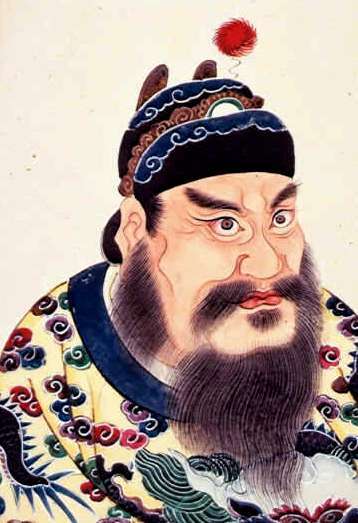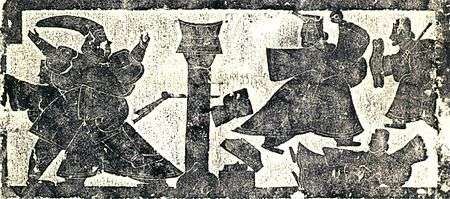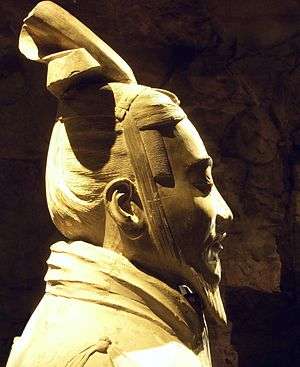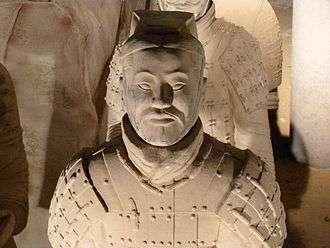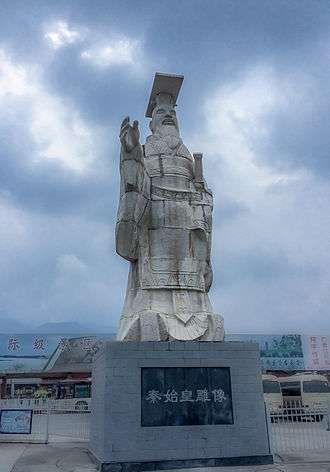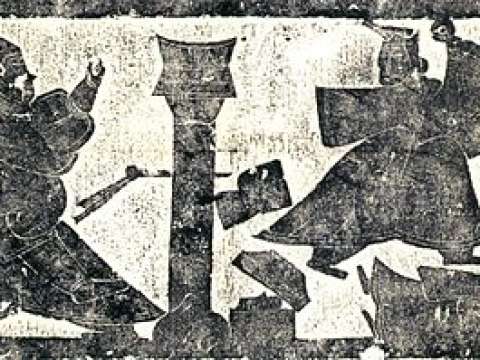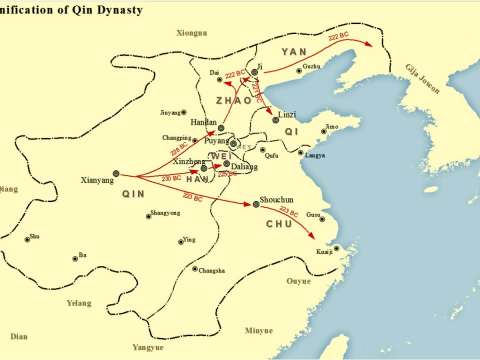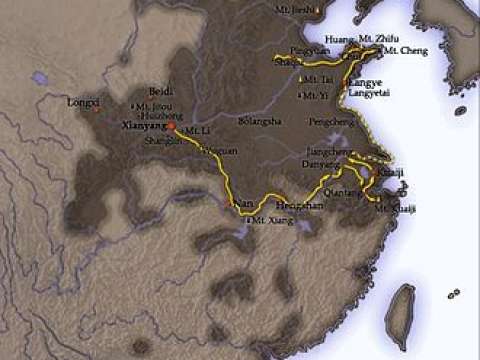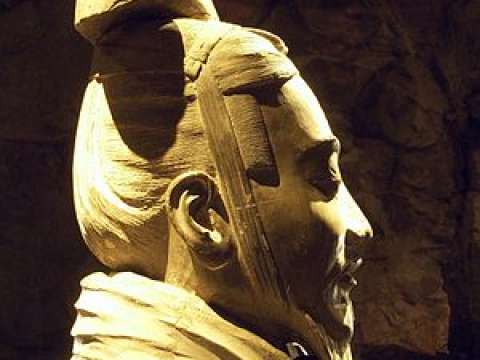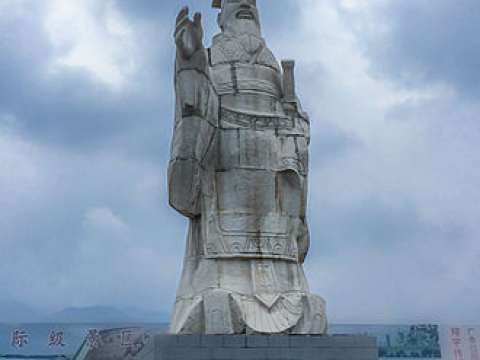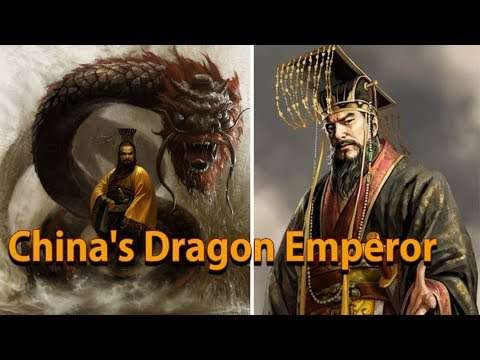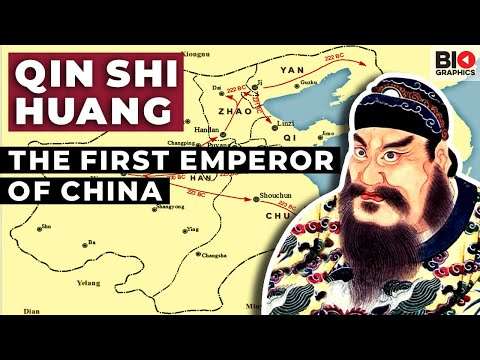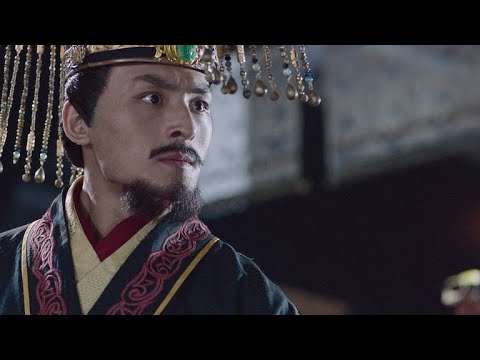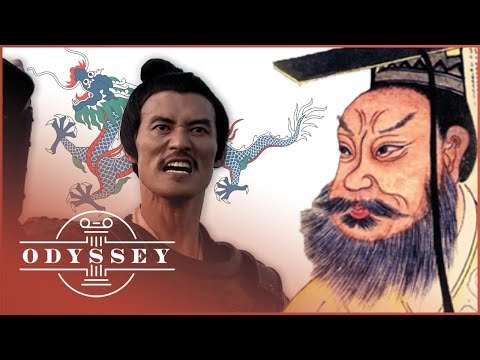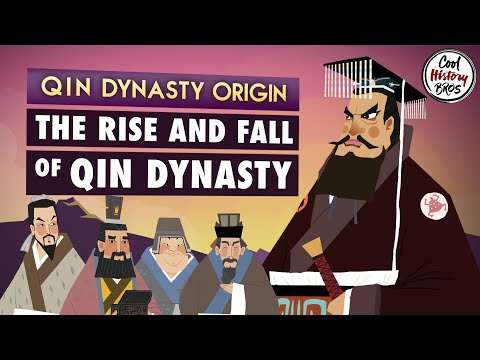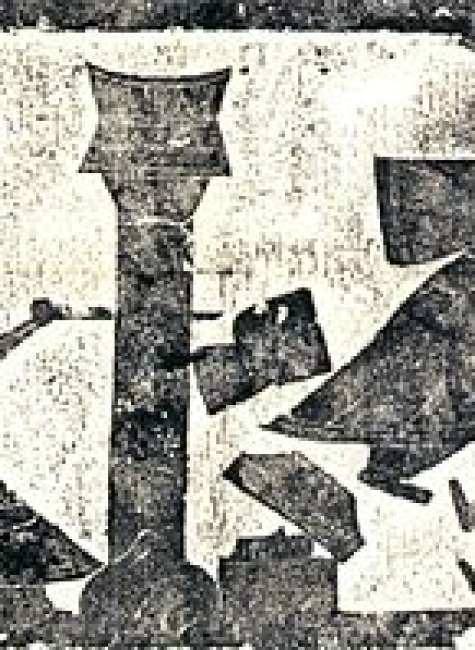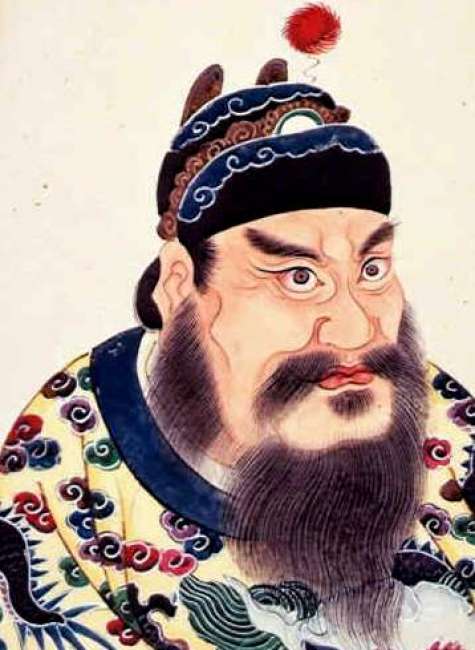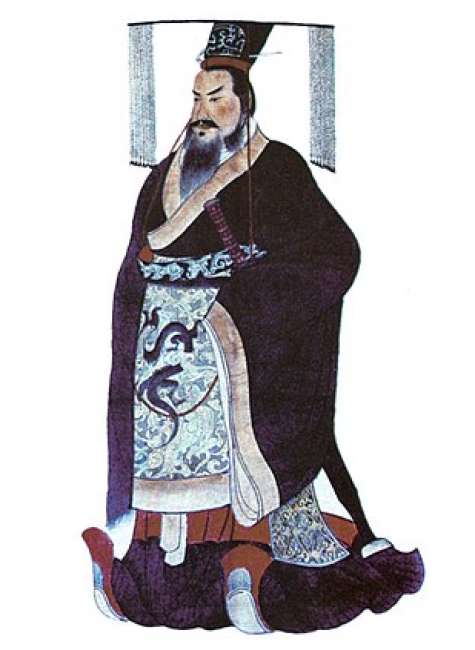

Qin Shi Huang (0259 B.C.-0210 B.C.)
The reason why All-under-Heaven suffers bitterly from endless wars is because of the existence of feudal lords and kings. A reliance on ancestral temples initially brought stability, but the revival of states results in the spread of soldiers. Doing so will never bring about stability!
Qin Shi Huang was the founder of the Qin dynasty and the first emperor of a unified China. From 247 to 221 BC he was Zheng, King of Qin , Qín Wáng Zhèng, personal name Yíng Zhèng or Zhào Zhèng. He became China's first emperor when he was 38 after the Qin had conquered all of the other Warring States and unified all of China in 221 BC. Rather than maintain the title of "king" wáng borne by the previous Shang and Zhou rulers, he ruled as the First Emperor of the Qin dynasty from 221 BC to 210 BC. His self-invented title "emperor" huángdì would continue to be borne by Chinese rulers for the next two millennia.
During his reign, his generals greatly expanded the size of the Chinese state: campaigns south of Chu permanently added the Yue lands of Hunan and Guangdong to the Chinese cultural orbit; campaigns in Central Asia conquered the Ordos Loop from the nomad Xiongnu, although eventually it would also lead to their confederation under Modu Chanyu.
Qin Shi Huang also worked with his minister Li Si to enact major economic and political reforms aimed at the standardization of the diverse practices of the earlier Chinese states. He is traditionally said to have banned and burned many books and executed scholars. His public works projects included the unification of diverse state walls into a single Great Wall of China and a massive new national road system, as well as the city-sized mausoleum guarded by the life-sized Terracotta Army. He ruled until his death in 210 BC during his fourth tour of Eastern China.
Origin of name
Modern Chinese sources often give the personal name of Qin Shi Huang as Ying Zheng, with Ying taken as the surname and Zheng the given name. In ancient China however the naming convention differed, and Zhao may be used as the surname. Unlike modern Chinese names, the nobles of ancient China had two distinct surnames: the ancestral name comprised a larger group descended from a prominent ancestor, usually said to have lived during the time of the Three Sovereigns and Five Emperors of Chinese legend, and the clan name 氏 comprised a smaller group that showed a branch's current fief or recent title. The ancient practice was to list men's names separately—Sima Qian's "Basic Annals of the First Emperor of Qin" introduces him as "given the name Zheng and the surname Zhao"—or to combine the clan surname with the personal name: Sima's account of Chu describes the sixteenth year of the reign of King Kaolie as "the time when Zhao Zheng was enthroned as King of Qin". However, since modern Chinese surnames despite usually descending from clan names use the same character as the old ancestral names, it is much more common in modern Chinese sources to see the emperor's personal name written as Ying Zheng, using the ancestral name of the Ying family.
The rulers of Qin had styled themselves kings from the time of King Huiwen in 325 BC. Upon his ascension, Zheng became known as the King of Qin or King Zheng of Qin. This title made him the nominal equal of the rulers of Shang and of Zhou, the last of whose kings had been deposed by King Zhaoxiang of Qin in 256 BC.

Following the surrender of Qi in 221 BC, King Zheng had reunited all of the lands of the former Kingdom of Zhou. Rather than maintain his rank as king, however, he created a new title of huángdì emperor for himself. This new title combined two titles—huáng of the mythical Three Sovereigns, Sān Huáng and the dì of the legendary Five Emperors, Wŭ Dì of Chinese prehistory. The title was intended to appropriate some of the prestige of the Yellow Emperor, whose cult was popular in the later Warring States period and who was considered to be a founder of the Chinese people. King Zheng chose the new regnal name of First Emperor Shǐ Huángdì, formerly transcribed as Shih Huang-ti on the understanding that his successors would be successively titled the "Second Emperor", "Third Emperor", and so on through the generations. In fact, the scheme lasted only as long as his immediate heir, the Second Emperor. The new title carried religious overtones. For that reason, Sinologists—starting with Peter Boodberg or Edward Schafer—sometimes translate it as "thearch" and the First Emperor as the First Thearch.
The First Emperor intended that his realm would remain intact through the ages but, following its overthrow and replacement by Han after his death, it became customary to prefix his title with Qin. Thus:
- Qín or Ch‘in, "of Qin"
- Shǐ or Shih, "first"
- Huángdì or Huang-ti, "emperor", a new term coined from, Huáng or Huang, literally "shining" or "splendid" and formerly most usually applied "as an epithet of Heaven", a title of the Three Sovereigns, the high god of the Zhou, Dì or Ti, the high god of the Shang, possibly composed of their divine ancestors, and used by the Zhou as a title of the legendary Five Emperors, particularly the Yellow Emperor
- Huáng or Huang, literally "shining" or "splendid" and formerly most usually applied "as an epithet of Heaven", a title of the Three Sovereigns, the high god of the Zhou
- Dì or Ti, the high god of the Shang, possibly composed of their divine ancestors, and used by the Zhou as a title of the legendary Five Emperors, particularly the Yellow Emperor
As early as Sima Qian, it was common to shorten the resulting four-character Qin Shi Huangdi to, variously transcribed as Qin Shihuang or Qin Shi Huang.
Following his elevation as emperor, both Zheng's personal name and possibly its homophone became taboo. The First Emperor also arrogated the first-person Chinese pronoun OC *lrəm’, mod. zhèn for his exclusive use and in 212 BC began calling himself The Immortal OC *Tin-niŋ, mod. Zhēnrén, lit. "True Man". Others were to address him as "Your Majesty", mod. Bìxià, lit. "Beneath the Palace Steps" in person and "Your Highness" 上 in writing.
Birth and parentage
According to the Records of the Grand Historian, written by Sima Qian during the Han dynasty, the first emperor was the eldest son of the Qin prince Yiren, who later became King Zhuangxiang of Qin. Prince Yiren at that time was residing at the court of Zhao, serving as a hostage to guarantee the armistice between the Qin and Zhao states. Prince Yiren had fallen in love at first sight with a concubine of Lü Buwei, a rich merchant from the State of Wey. Lü consented for her to be Yiren's wife, who then became known as Lady Zhao Zhao Ji after the state of Zhao. Lady Zhao gave birth to the child on 18 February; and he was given the name Zhao Zheng—the name Zheng 正 came from his month of birth Zhengyue, the first month of the Chinese lunar calendar; the clan name of Zhao came from his father's lineage and was unrelated to either his mother's name or the location of his birth. Lü Buwei's machinations later helped Yiren become King Zhuangxiang of Qin in 250 BC.
However, the Records of the Grand Historian also claimed that the first emperor was not the actual son of Prince Yiren but that of Lü Buwei. According to this account, when Lü Buwei introduced the dancing girl to the prince, she was Lü Buwei's concubine and had already become pregnant by him, and the baby was born after an unusually long period of pregnancy. According to translations of the Annals of Lü Buwei, Zhao Ji gave birth to the future emperor in the city of Handan in 259 BC, the first month of the 48th year of King Zhaoxiang of Qin.
The idea that the emperor was an illegitimate child, widely believed throughout Chinese history, contributed to the generally negative view of the First Emperor. However, a number of modern scholars have doubted this account of his birth. Sinologist Derk Bodde wrote: "There is good reason for believing that the sentence describing this unusual pregnancy is an interpolation added to the Shih-chi by an unknown person in order to slander the First Emperor and indicate his political as well as natal illegitimacy". John Knoblock and Jeffrey Riegel, in their translation of Lü Buwei's Spring and Autumn Annals, call the story "patently false, meant both to libel Lü and to cast aspersions on the First Emperor". Claiming Lü Buwei—a merchant—as the First Emperor's biological father was meant to be especially disparaging, since later Confucian society regarded merchants as the lowest of all social classes.
As the King of Qin
Regency
In 246 BC, when King Zhuangxiang died after a short reign of just three years, he was succeeded on the throne by his 13-year-old son. At the time, Zhao Zheng was still young, so Lü Buwei acted as the regent prime minister of the State of Qin, which was still waging war against the other six states. Nine years later, in 235 BC, Zhao Zheng assumed full power after Lü Buwei was banished for his involvement in a scandal with Queen Dowager Zhao.

Zhao Chengjiao, the Lord Chang'an, was Zhao Zheng's legitimate half-brother, by the same father but from a different mother. After Zhao Zheng inherited the throne, Chengjiao rebelled at Tunliu and surrendered to the state of Zhao. Chengjiao's remaining retainers and families were executed by Zhao Zheng.
Lao Ai's attempted coup
As King Zheng grew older, Lü Buwei became fearful that the boy king would discover his liaison with his mother Lady Zhao. He decided to distance himself and look for a replacement for the queen dowager. He found a man named Lao Ai. According to The Record of Grand Historian, Lao Ai was disguised as a eunuch by plucking his beard. Later Lao Ai and queen Zhao Ji got along so well they secretly had two sons together. Lao Ai then became ennobled as Marquis Lào Ǎi, and was showered with riches. Lao Ai's plot was supposed to replace King Zheng with one of the hidden sons. But during a dinner party drunken Lào Ǎi was heard bragging about being the young king's step father. In 238 BC the king was travelling to the ancient capital of Yōng. Lao Ai seized the queen mother's seal and mobilized an army in an attempt to start a coup and rebel. When King Zheng discovered this fact, he ordered Lü Buwei to let Lord Changping and Lord Changwen attack Lao Ai. Although the royal army killed hundreds of rebels at the capital, Lao Ai succeeded in fleeing from this battle.
A price of 1 million copper coins was placed on Lao Ai's head if he was taken alive or half a million if dead. Lao Ai's supporters were captured and beheaded; then Lao Ai was tied up and torn to five pieces by horse carriages, while his entire family was executed to the third degree. The two hidden sons were also killed, while mother Zhao Ji was placed under house arrest until her death many years later. Lü Buwei drank a cup of poison wine and committed suicide in 235 BC. Ying Zheng then assumed full power as the King of the Qin state. Replacing Lü Buwei, Li Si became the new chancellor.
First attempted assassination
King Zheng and his troops continued to take over different states. The state of Yan was small, weak and frequently harassed by soldiers. It was no match for the Qin state. So Crown Prince Dan of Yan plotted an assassination attempt to get rid of King Zheng, begging Jing Ke to go on the mission in 227 BC. Jing Ke was accompanied by Qin Wuyang in the plot. Each was supposed to present a gift to King Zheng: a map of Dukang and the severed head of Fan Wuji.

Qin Wuyang first tried to present the map case gift, but trembled in fear and moved no further towards the king. Jing Ke continued to advance toward the king, while explaining that his partner "has never set eyes on the Son of Heaven", which is why he is trembling. Jing Ke had to present both gifts by himself. While unrolling the map, a dagger was revealed. The king drew back, stood on his feet, but struggled to draw the sword to defend himself. At the time, other palace officials were not allowed to carry weapons. Jing Ke pursued the king, attempting to stab him, but missed. King Zheng drew out his sword and cut Jing Ke's thigh. Jing Ke then threw the dagger, but missed again. Suffering eight wounds from the king's sword, Jing Ke realized his attempt had failed and knew that both of them would be killed afterwards. The Yan state was conquered by the Qin state five years later.
Second attempted assassination
Gao Jianli was a close friend of Jing Ke, who wanted to avenge his death. As a famous lute player, one day he was summoned by King Zheng to play the instrument. Someone in the palace who had known him in the past exclaimed, "This is Gao Jianli". Unable to bring himself to kill such a skilled musician, the emperor ordered his eyes put out. But the king allowed Gao Jianli to play in his presence. He praised the playing and even allowed Gao Jianli to get closer. As part of the plot, the lute was fastened with a heavy piece of lead. He raised the lute and struck at the king. He missed, and his assassination attempt failed. Gao Jianli was later executed.
Unification of China
In 230 BC, King Zheng unleashed the final campaigns of the Warring States period, setting out to conquer the remaining independent kingdoms, one by one.
The first state to fall was Hán; sometimes called Hann to distinguish it from the Hàn of Han dynasty, in 230 BC. Then Qin took advantage of natural disasters in 229 BC to invade and conquer Zhào, where Qin Shi Huang had been born. He now avenged his poor treatment as a child hostage there, seeking out and killing his enemies.
Qin armies conquered the state of Zhao in 228 BC, the northern country of Yan in 226 BC, the small state of Wei in 225 BC, and the largest state and greatest challenge, Chu, in 223 BC.

In 222 BC, the last remnants of Yan and the royal family were captured in Liaodong in the northeast. The only independent country left was now state of Qi, in the far east, what is now the Shandong peninsula. Terrified, the young king of Qi sent 200,000 people to defend his western borders. In 221 BC, the Qin armies invaded from the north, captured the king, and annexed Qi. Some of the strategies Qin used to unify China were to standardize the trade and communication, currency and language.
For the first time, all Chinese lands were unified under one powerful ruler. In that same year, King Zheng proclaimed himself the "First Emperor" 始皇帝, Shǐ Huángdì, no longer a king in the old sense and now far surpassing the achievements of the old Zhou Dynasty rulers. The emperor ordered the Heshibi to be made into the Imperial Seal, known as the "Heirloom Seal of the Realm". The words, "Having received the Mandate from Heaven, may the emperor lead a long and prosperous life." were written by Prime Minister Li Si, and carved onto the seal by Sun Shou. The Seal was later passed from emperor to emperor for generations to come.
In the South, military expansion in the form of campaigns against the Yue tribes continued during his reign, with various regions being annexed to what is now Guangdong province and part of today's Vietnam.
As the Emperor of Qin
Administrative reforms
In an attempt to avoid a recurrence of the political chaos of the Warring States period, Qin Shi Huang and his prime minister Li Si completely abolished feudalism. The empire was then divided into 36 commanderies, Jùn, later more than 40 commanderies. The whole of China was thus divided into administrative units: first commanderies, then counties, Xiàn, townships, Xiāng and hundred-family units Li, which roughly corresponds to the modern-day subdistricts and communities. This system was different from the previous dynasties, which had loose alliances and federations. People could no longer be identified by their native region or former feudal state, as when a person from Chu was called "Chu person", Chu rén. Appointments were subsequently based on merit instead of hereditary rights.
Economic reforms
Qin Shi Huang and Li Si unified China economically by standardizing the Chinese units of measurements such as weights and measures, the currency, and the length of the axles of carts to facilitate transport on the road system. The emperor also developed an extensive network of roads and canals connecting the provinces to improve trade between them. The currencies of the different states were also standardized to the Ban liang coin Bàn Liǎng. Perhaps most importantly, the Chinese script was unified. Under Li Si, the seal script of the state of Qin was standardized through removal of variant forms within the Qin script itself. This newly standardized script was then made official throughout all the conquered regions, thus doing away with all the regional scripts to form one language, one communication system for all of China.
Philosophy
Qin Shi Huang also followed the school of the five elements, earth, wood, metal, fire and water. Zhao Zheng's birth element is water, which is connected with the colour black. It was also believed that the royal house of the previous dynasty Zhou had ruled by the power of fire, which was the colour red. The new Qin dynasty must be ruled by the next element on the list, which is water, represented by the colour black. Black became the colour for garments, flags, pennants. Other associations include north as the cardinal direction, winter season and the number six. Tallies and official hats were 15 centimetres 5.9 inches long, carriages two metres 6.6 feet wide, one pace; Bù was 1.4 metres 4.6 ft.
While the previous Warring States era was one of constant warfare, it was also considered the golden age of free thought. Qin Shi Huang eliminated the Hundred Schools of Thought which incorporated Confucianism and other philosophies. After the unification of China, with all other schools of thought banned, legalism became the endorsed ideology of the Qin dynasty, which was basically a system that required the people to follow the laws or be punished accordingly.

Beginning in 213 BC, at the instigation of Li Si and to avoid scholars' comparisons of his reign with the past, Qin Shi Huang ordered most existing books to be burned with the exception of those on astrology, agriculture, medicine, divination, and the history of the State of Qin. This would also serve the purpose of furthering the ongoing reformation of the writing system by removing examples of obsolete scripts. Owning the Book of Songs or the Classic of History was to be punished especially severely. According to the later Records of the Grand Historian, the following year Qin Shi Huang had some 460 scholars buried alive for owning the forbidden books. The emperor's oldest son Fusu criticised him for this act.
Recent research suggests that the "burying of the Confucian scholars alive" is a Confucian martyrs' legend; rather, the emperor ordered the killing kēng of a group of alchemists after having found that they had fooled him. In Han times, the Confucian scholars, who had served the Qin loyally, used that incident to distance themselves from the failed dynasty. Kong Anguo c. 165 – c. 74 BC, a descendant of Confucius, turned the alchemists fāngshì into Confucianists rú and entwined the martyrs' legend with the strange story of the rediscovery of the lost Confucian books behind a demolished wall in the house of his ancestors. The emperor's own library still had copies of the forbidden books but most of these were destroyed later when Xiang Yu burned the palaces of Xianyang in 206 BC.
Third attempted assassination
In 230 BC, the state of Qin had defeated the state of Han. A Han aristocrat named Zhang Liang swore revenge on the Qin emperor. He sold all his valuables and in 218 BC, he hired a strongman assassin and built him a heavy metal cone weighing 120 jin roughly 160 lb or 97 kg. The two men hid among the bushes along the emperor's route over a mountain. At a signal, the muscular assassin hurled the cone at the first carriage and shattered it. However, the emperor was actually in the second carriage, as he was travelling with two identical carriages for this very reason. Thus the attempt failed. Both men were able to escape in spite of a huge manhunt.
Public works
Great Wall
The Qin fought nomadic tribes to the north and north-west. The Xiongnu tribes were not defeated and subdued, thus the campaign was tiring and unsuccessful, and to prevent the Xiongnu from encroaching on the northern frontier any longer, the emperor ordered the construction of an immense defensive wall. This wall, for whose construction hundreds of thousands of men were mobilized, and an unknown number died, is a precursor to the current Great Wall of China. It connected numerous state walls which had been built during the previous four centuries, a network of small walls linking river defences to impassable cliffs.

Intending to impose centralized rule and prevent the resurgence of feudal lords, Ying Zheng ordered the destruction of the sections of the walls that divided his empire among the former states. To position the empire against the Xiongnu people from the north, however, he ordered the building of new walls to connect the remaining fortifications along the empire's northern frontier. "Build and move on" was a central guiding principle in constructing the wall, implying that the Chinese were not erecting a permanently fixed border. Transporting the large quantity of materials required for construction was difficult, so builders always tried to use local resources. Stones from the mountains were used over mountain ranges, while rammed earth was used for construction in the plains. There are no surviving historical records indicating the exact length and course of the Qin walls. Most of the ancient walls have eroded away over the centuries, and very few sections remain today. The human cost of the construction is unknown, but it has been estimated by some authors that hundreds of thousands, if not up to a million, workers died building the Qin wall.
Lingqu Canal
A famous South China quotation was "In the North there is the Great wall, in the South there is the Lingqu canal"; Běiyǒu chángchéng, nányǒu língqú. In 214 BC the Emperor began the project of a major canal to transport supplies to the army. The canal allows water transport between north and south China. The canal, 34 kilometres in length, links the Xiang River which flows into the Yangtze and the Li Jiang, which flows into the Pearl River. The canal connected two of China's major waterways and aided Qin's expansion into the south-west. The construction is considered one of the three great feats of Ancient Chinese engineering, the others being the Great Wall and the Sichuan Dujiangyan Irrigation System.
Elixir of life
Later in his life, Qin Shi Huang feared death and desperately sought the fabled elixir of life, which would supposedly allow him to live forever. He was obsessed with acquiring immortality and fell prey to many who offered him supposed elixirs. He visited Zhifu Island three times in order to achieve immortality.
In one case he sent Xu Fu, a Zhifu islander, with ships carrying hundreds of young men and women in search of the mystical Penglai mountain. They were sent to find Anqi Sheng, a 1,000-year-old magician whom Qin Shi Huang had supposedly met in his travels and who had invited him to seek him there. These people never returned, perhaps because they knew that if they returned without the promised elixir, they would surely be executed. Legends claim that they reached Japan and colonized it. It is also possible that the book burning, a purge on what could be seen as wasteful and useless literature, was, in part, an attempt to focus the minds of the Emperor's best scholars on the alchemical quest. Some of the executed scholars were those who had been unable to offer any evidence of their supernatural schemes. This may have been the ultimate means of testing their abilities: if any of them had magic powers, then they would surely come back to life when they were let out again. Since the great emperor was afraid of death and "evil spirits", he had workers build a series of tunnels and passageways to each of his palaces he owned over 200, because traveling unseen would supposedly keep him safe from the evil spirits.
Death and post-mortem events
In 211 BC a large meteor is said to have fallen in Dongjun in the lower reaches of the Yellow River. On it, an unknown person inscribed the words "The First Emperor will die and his land will be divided". When the emperor heard of this, he sent an imperial secretary to investigate this prophecy. No one would confess to the deed, so all the people living nearby were put to death. The stone was then pulverized.

During his fifth tour of Eastern China, the Emperor became seriously ill after he arrived in Pingyuanjin Pingyuan County, Shandong, and died on 10 September 210 BC Julian Calendar at the palace in Shaqiu prefecture, Shāqiū Píngtái, about two months away by road from the capital Xianyang.
The cause of Qin Shi Huang's death is still largely unknown. Reportedly, he died from Chinese alchemical elixir poisoning due to ingesting mercury pills, made by his alchemists and court physicians, believing it to be an elixir of immortality. A possible contributing factor was illness due to the stress of running the empire.
Second Emperor conspiracy
After the Emperor's death, Prime Minister Li Si, who accompanied him, became extremely worried that the news of his death could trigger a general uprising in the Empire. It would take two months for the entourage to reach the capital, and it would not be possible to stop the uprising. Li Si decided to hide the death of the Emperor, and return to Xianyang. Most of the Imperial entourage accompanying the Emperor were left ignorant of the Emperor's death; only a younger son, Ying Huhai, who was travelling with his father, the eunuch Zhao Gao, Li Si, and five or six favourite eunuchs knew of the death. Li Si also ordered that two carts containing rotten fish be carried immediately before and after the wagon of the Emperor. The idea behind this was to prevent people from noticing the foul smell emanating from the wagon of the Emperor, where his body was starting to decompose severely as it was summertime. They also pulled down the shade so no one could see his face, changed his clothes daily, brought food and when he had to have important conversations, they would act as if he wanted to send them a message.
Eventually, after about two months, Li Si and the imperial court reached Xianyang, where the news of the death of the emperor was announced. Qin Shi Huang did not like to talk about his own death and he had never written a will. After his death, the eldest son Fusu would normally become the next emperor.

Li Si and the chief eunuch Zhao Gao conspired to kill Fusu because Fusu's favorite general was Meng Tian, whom they disliked and feared; Meng Tian's brother, a senior minister, had once punished Zhao Gao. They believed that if Fusu was enthroned, they would lose their power. Li Si and Zhao Gao forged a letter from Qin Shi Huang saying that both Fusu and General Meng must commit suicide. The plan worked, and the younger son Hu Hai became the Second Emperor, later known as Qin Er Shi or "Second Generation Qin".
Qin Er Shi, however, was not as capable as his father. Revolts quickly erupted. His reign was a time of extreme civil unrest, and everything built by the First Emperor crumbled away within a short period. One of the immediate revolt attempts was the 209 BC Daze Village Uprising led by Chen Sheng and Wu Guang.
Family
The following are some family members of Qin Shi Huang:
- Parents King Zhuangxiang of Qin Empress Mother
- King Zhuangxiang of Qin
- Empress Mother
- Half siblings: Chengjiao, legitimate paternal half brother from a different mother Lord of Chang'an Two illegitimate maternal half-brothers born to Queen Dowager Zhao and Lao Ai.
- Chengjiao, legitimate paternal half brother from a different mother Lord of Chang'an
- Two illegitimate maternal half-brothers born to Queen Dowager Zhao and Lao Ai.
- Children: Fusu, Crown Prince 1st son Gao Jianglü Huhai, later Qin Er Shi 18th son disputed Ying, later King of Qin
- Fusu, Crown Prince 1st son
- Gao
- Jianglü
- Huhai, later Qin Er Shi 18th son
- disputed Ying, later King of Qin
Qin Shi Huang had about 50 children about 30 sons and 15 daughters, but most of their names are unknown. He had numerous concubines but appeared to have never named an empress.
Legacy
Mausoleum
The Chinese historian Sima Qian, writing a century after the First Emperor's death, wrote that it took 700,000 men to construct the emperor's mausoleum. British historian John Man points out that this figure is larger than the population of any city in the world at that time and he calculates that the foundations could have been built by 16,000 men in two years. While Sima Qian never mentioned the terracotta army, the statues were discovered by a group of farmers digging wells on 29 March 1974. The soldiers were created with a series of mix-and-match clay molds and then further individualized by the artists' hand. Han Purple was also used on some of the warriors. There are around 6,000 Terracotta Warriors and their purpose was to protect the Emperor in the afterlife from evil spirits. Also among the army are chariots and 40,000 real bronze weapons.

One of the first projects which the young king accomplished while he was alive was the construction of his own tomb. In 215 BC Qin Shi Huang ordered General Meng Tian to begin its construction with the assistance of 300,000 men. Other sources suggest that he ordered 720,000 unpaid laborers to build his tomb according to his specifications. Again, given John Man's observation regarding populations at the time see paragraph above, these historical estimates are debatable. The main tomb located at 34°22′53″N 109°15′13″E / 34.38139°N 109.25361°E / 34.38139; 109.25361 containing the emperor has yet to be opened and there is evidence suggesting that it remains relatively intact. Sima Qian's description of the tomb includes replicas of palaces and scenic towers, "rare utensils and wonderful objects", 100 rivers made with mercury, representations of "the heavenly bodies", and crossbows rigged to shoot anyone who tried to break in. The tomb was built at the foot of Mount Li, 30 kilometers away from Xi'an. Modern archaeologists have located the tomb, and have inserted probes deep into it. The probes revealed abnormally high quantities of mercury, some 100 times the naturally occurring rate, suggesting that some parts of the legend are credible. Secrets were maintained, as most of the workmen who built the tomb were killed.
Historiography
Traditional Chinese historiography almost always portrayed the First Emperor of the Chinese unified states as a brutal tyrant who had an obsessive fear of assassination. Ideological antipathy towards the Legalist State of Qin was established as early as 266 BC, when Confucian philosopher Xunzi disparaged it. Later Confucian historians condemned the emperor who had burned the classics and had buried Confucian scholars alive. They eventually compiled a list of the Ten Crimes of Qin to highlight his tyrannical actions.
The famous Han poet and statesman Jia Yi concluded his essay The Faults of Qin, Guò Qín Lùn with what was to become the standard Confucian judgment of the reasons for Qin's collapse. Jia Yi's essay, admired as a masterpiece of rhetoric and reasoning, was copied into two great Han histories and has had a far-reaching influence on Chinese political thought as a classic illustration of Confucian theory. He attributed Qin's disintegration to its internal failures. Jia Yi wrote that:
Imperial tours of Qin Shi HuTerracotta Army CQin, from a tiny base, had become a great power, ruling the land and receiving homage from all quarters for a hundred odd years. Yet after they unified the land and secured themselves within the pass, a single common rustic could nevertheless challenge this empire... Why? Because the ruler lacked humaneness and rightness; because preserving power differs fundamentally from seizing power.olonel-in-Chiefang
In more modern times, historical assessment of the First Emperor different from traditional Chinese historiography began to emerge. The reassessment was spurred on by the weakness of China in the latter half of the 19th century and early 20th century. At that time some began to regard Confucian traditions as an impediment to China's entry into the modern world, opening the way for changing perspectives.
At a time when foreign nations encroached upon Chinese territory, leading Kuomintang historian Xiao Yishan emphasized the role of Qin Shi Huang in repulsing the northern barbarians, particularly in the construction of the Great Wall.
Another historian, Ma Feibai, published in 1941 a full-length revisionist biography of the First Emperor entitled Qín Shǐ Huángdì Zhuàn, calling him "one of the great heroes of Chinese history". Ma compared him with the contemporary leader Chiang Kai-shek and saw many parallels in the careers and policies of the two men, both of whom he admired. Chiang's Northern Expedition of the late 1920s, which directly preceded the new Nationalist government at Nanjing was compared to the unification brought about by Qin Shi Huang.

With the coming of the Communist Revolution and the establishment of a new, revolutionary regime in 1949, another re-evaluation of the First Emperor emerged as a Marxist critique. This new interpretation of Qin Shi Huang was generally a combination of traditional and modern views, but essentially critical. This is exemplified in the Complete History of China, which was compiled in September 1955 as an official survey of Chinese history. The work described the First Emperor's major steps toward unification and standardisation as corresponding to the interests of the ruling group and the merchant class, not of the nation or the people, and the subsequent fall of his dynasty as a manifestation of the class struggle. The perennial debate about the fall of the Qin Dynasty was also explained in Marxist terms, the peasant rebellions being a revolt against oppression—a revolt which undermined the dynasty, but which was bound to fail because of a compromise with "landlord class elements".
Since 1972, however, a radically different official view of Qin Shi Huang in accordance with Maoist thought has been given prominence throughout China. Hong Shidi's biography Qin Shi Huang initiated the re-evaluation. The work was published by the state press as a mass popular history, and it sold 1.85 million copies within two years. In the new era, Qin Shi Huang was seen as a far-sighted ruler who destroyed the forces of division and established the first unified, centralized state in Chinese history by rejecting the past. Personal attributes, such as his quest for immortality, so emphasized in traditional historiography, were scarcely mentioned. The new evaluations described approvingly how, in his time an era of great political and social change, he had no compunctions against using violent methods to crush counter-revolutionaries, such as the "industrial and commercial slave owner" chancellor Lü Buwei. However, he was criticized for not being as thorough as he should have been, and as a result, after his death, hidden subversives under the leadership of the chief eunuch Zhao Gao were able to seize power and use it to restore the old feudal order.
To round out this re-evaluation, Luo Siding put forward a new interpretation of the precipitous collapse of the Qin Dynasty in an article entitled "On the Class Struggle During the Period Between Qin and Han" in a 1974 issue of Red Flag, to replace the old explanation. The new theory claimed that the cause of the fall of Qin lay in the lack of thoroughness of Qin Shi Huang's "dictatorship over the reactionaries, even to the extent of permitting them to worm their way into organs of political authority and usurp important posts."
Mao Zedong, chairman of the People's Republic of China, was reviled for his persecution of intellectuals. On being compared to the First Emperor, Mao responded:
Tom Ambrose characterises Qin Shi Huang as the founder of "the first police state in history".
Cultural references
- "The Wall and the Books" "La muralla y los libros", an acclaimed essay on Qin Shi Huang published by Argentine writer Jorge Luis Borges 1899–1986 in the 1952 collection Other Inquisitions Otras Inquisiciones.
- Shin no Shikoutei [ja] 1962 – The film portrays Qin Shi Huang as a battle-hardened emperor with his roots in the military.[citation needed]
- Big Trouble in Little China 1986 – Qin Shi Huang is mentioned as having defeated the film's main villain, Lo Pan, in battle, and subsequently cursing him to live as a ghost. The events of the film revolve around Lo Pan's attempts to break the curse.
- The Emperor's Shadow 1996 – The film focuses on Qin Shi Huang's relationship with the musician Gao Jianli, a friend of the assassin Jing Ke.
- The Emperor and the Assassin 1999 – The film covers much of Ying Zheng's career, recalling his early experiences as a hostage and foreshadowing his dominance over China.
- Hero 2002 – The film stars Jet Li, a nameless assassin who plans an assassination attempt on the King of Qin Chen Daoming. The film is a fictional re-imagining of the assassination attempt by Jing Ke on Qin Shi Huang.
- Rise of the Great Wall 1986 – a 63-episode Hong Kong TV series chronicling the events from the emperor's birth until his death. Tony Liu played Qin Shi Huang.
- A Step into the Past 2001 – a Hong Kong TVB production based on a science fiction novel by Huang Yi.
- Qin Shi Huang 2002 – a mainland Chinese TV series production. It features a semi-fictionalized story of the emperor's life, from his childhood until his death. Zhang Fengyi starred as Qin Shi Huang.
- Kingdom 2006 – a Japanese manga that provides a fictionalized account of the unification of China by Ying Zheng with Li Xin and all the people that contributed to the conquest of the six Warring States.
- Fate/Grand Order 2015, an online, free-to-play role-playing mobile game of the Fate franchise developed by Delightworks and published by Aniplex features Qin Shi Huang as a Ruler class servant.
- First Emperor: The Man Who Made China 2006 – a drama-documentary special about Qin Shi Huang. James Pax played the emperor. It was shown on Channel 4 in the United Kingdom in 2006.
- China's First Emperor 2008 – a special three-hour documentary by The History Channel. Xu Pengkai played Qin Shi Huang.
- In the 2005 4X video game Civilization IV developed by Firaxis Games, Qin Shi Huang is one of the two playable leaders of China, with the other being Mao Zedong. Qin Shi Huang would later reappear in the 2016 4X video game Civilization VI developed by Firaxis Games to lead the Chinese civilization once again.
- Qin Shi Huang would later reappear in the 2016 4X video game Civilization VI developed by Firaxis Games to lead the Chinese civilization once again.
More facts
China's Dragon Emperor (2018)
Qing Shi Huang Fei (2011-)
The First Emperor (2006)


